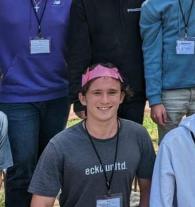Due to the current situation we are experiencing significant demand for tutoring. Fast track your enrolment online:
Enrol Online Now

Working with Children Check
 Verified Tutor
Verified Tutor
 Verified Tutor
Verified Tutor

What do I enjoy most about tutoring? 😁
I find great satisfaction in being able to assist others. When my peers and friends seek my help with specific questions, I draw upon my existing knowledge to successfully guide them and ensure their understanding. Experiencing their excitement and accomplishment brings me equal joy!My Strengths as Tutor 💪
As a first-year engineering student at UNSW, I am passionate about supporting my peers. I have a strong tutoring background, both in high school and university, where I have helped my friends excel in their studies. With a solid foundation in physics and advanced mathematics, I achieved an ATAR of 94. Also, I completed a university course that enhanced my communication skills and ability to connect with others. Additionally, I am patient, easy to get along with, and a good listener. Drawing from my past tutoring experiences, I am dedicated and believe I can make a positive impact as a tutor.Most important things I can do for a student 🏅
Through previous tutoring experience, I’m particular good at sportify where the student gets stuck on or what concept they’ve messed up at the start of tutoring and therefore offer help according to their learning styles and foundations. This is the thing I think most important during tutoring: support the students base on their own understanding and fundamental level.Tutoring students in 👦 👧
- year 1
- year 2
- year 3
- year 4
- year 5
- year 6
- year 7
- year 8
- year 9











Recent Tutoring Comments:
The student understands and can use the gradient intercept quite well. She is able to identify the gradient and y-intercept directly through an expression, and is ...
The student understands and can use the gradient intercept quite well. She is able to identify the gradient and y-intercept directly through an expression, and is able to draw the graph using gradient-intercept formula, except from the table-of-values method that she learnt to use before. The student is able to understand linear models and find correspond y-value based on the graph and x-value.
The HSC question involving concept of linear models makes the students feel challenged. This is because the question has several layers and steps to go through and the answer cannot be obtained through one step or one calculation. It's helpful to break the questions down and go through each step to find the answer. It's possible for the student to get the final answer correctly as she understands the concept that's being assessed quite well.
The student was able to understand the new concept quite well (what's intercept, how to find an intercept), which obviously means the student pay attention in class ...
The student was able to understand the new concept quite well (what's intercept, how to find an intercept), which obviously means the student pay attention in class as well. The student made progress from previous topic, including variable identifying and graph drawing.
Sometimes the student forgot concept from previous chapters (what's absolute errors, the formulas related to measurement errors). It's important to keep them in mind as there will be test assessing the whole concept. Therefore, regularly revising chapters that've been down previously is important. The revision can be done through practicing exercises.
The student is good at using formulas to find the answers and explain the concept in the questions quite well once she got it and understand it. The student is able ...
The student is good at using formulas to find the answers and explain the concept in the questions quite well once she got it and understand it. The student is able to identify the relationship of sides using addition or subtraction is she cannot get the relationship directly from the question.
The student sometimes finds it difficult to analysis the question and hence apply the formulas. More practice on this type of question will help a lot.
The student is able to identify the time difference (which area is ahead of the other) based on the description in question. The student went well on calculating ...
The student is able to identify the time difference (which area is ahead of the other) based on the description in question. The student went well on calculating local time based on the time difference and time in another location. The student can do latitude and longitude base on graph and was able to explain it quite well.
Sometimes if there's day changes in the time difference, the student needs some help to get the correct result. Doing questions like latitude and time difference, drawing graph to represent the relationship can be very helpful. The student needs more practice to derive the graph by herself.